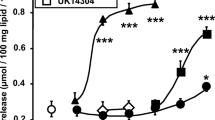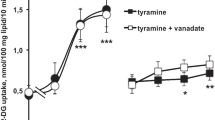Abstract
The weight loss observed in consumers of extracts of Citrus aurantium (bitter orange) has been tentatively attributed to the lipolytic and thermogenic effects of the alkaloids abundant in the unripe fruit. Synephrine, octopamine, tyramine, and other alkaloids have been repeatedly identified and quantified in Citrus members of the Rutaceae family or in their extracts incorporated in dietary supplements for weight management. However, there are only scarce reports on their lipolytic action. This study aimed at comparing the acute lipolytic activity of synephrine, octopamine, tyramine, and N-methyltyramine in rat and human adipocytes. Maximal response to the prototypical β-adrenergic agonist isoprenaline was taken as reference in both species. In rat, octopamine was slightly more active than synephrine while tyramine and N-methyl tyramine did not stimulate—and even inhibited—lipolysis. In human adipocytes, none of these amines stimulated lipolysis when tested up to 10 μg/ml. At higher doses (≥100 μg/ml), tyramine and N-methyl tyramine induced only 20% of the maximal lipolysis and exhibited antilipolytic properties. Synephrine and octopamine were partially stimulatory at high doses. Since synephrine is more abundant than octopamine in C. aurantium, it should be the main responsible for the putative lipolytic action of the extracts claimed to mitigate obesity. Noteworthy, their common isopropyl derivative, isopropylnorsynephrine (also named isopropyloctopamine or betaphrine), was clearly lipolytic: active at 1 μg/ml and reproducing more than 60% of isoprenaline maximal effect in human adipocytes. This compound, not detected in C. aurantium, and which has few reported adverse effects to date, might be useful for in vivo triglyceride breakdown.




Similar content being viewed by others
References
Anderson WG (1983) The sympathomimetic activity of N-isopropyloctopamine in vitro. J Pharmacol Exp Ther 25:553–558
Arbo MD, Larentis ER, Linck VM, Aboy AL, Pimentel AL, Henriques AT, Dallegrave E, Garcia SC, Leal MB, Limberger RP (2008) Concentrations of p-synephrine in fruits and leaves of Citrus species (Rutaceae) and the acute toxicity testing of Citrus aurantium extract and p-synephrine. Food Chem Toxicol 46:2770–2775
Arbo MD, Schmitt GC, Limberger MF, Charão MF, Moro AM, Ribeiro GL, Dallegrave E, Garcia SC, Leal MB, Limberger RP (2009) Subchronic toxicity of Citrus aurantium L. (Rutaceae) extract and p-synephrine in mice. Regul Toxicol Pharmacol 54:114–117
Atgié C, Hadj-Sassi L, Bukowiecki L, Mauriège P (2009) High lipolytic activity and dyslipidemia in a spontaneous hypertensive/NIH corpulent (SHR/N-cp) rat: a genetic model of obesity and type 2 diabetes mellitus. J Physiol Biochem 65:33–42
Atgié C, Sauvant P, Ambid L, Carpéné C (2009) Possible mechanisms of weight loss of Siberian hamsters (Phodopus sungorus sungorus) exposed to short photoperiod. J Physiol Biochem 65:377–386
Bour S, Visentin V, Prévot D, Carpéné C (2003) Moderate weight-lowering effect of octopamine treatment in obese Zucker rats. J Physiol Biochem 59:175–182
Bour S, Iglesias-Osma MC, Marti L, Duro P, Garcia-Barrado M, Pastor M-F, Prévot D, Visentin V, Valet P, Moratinos J, Carpéné C (2006) The imidazoline I2-site ligands BU 224 and 2-BFI inhibit MAO-A and MAO-B activities, hydrogen peroxide production, and lipolysis in rodent and human adipocytes. Eur J Pharmacol 552:20–30
Carpéné C, Bousquet-Mélou A, Galitzky J, Berlan M, Lafontan M (1998) Lipolytic effects of beta1-, beta2-, and beta3-adrenergic agonists in white adipose tissue of mammals. Ann NY Sci 839:186–189
Carpéné C, Galitzky J, Fontana E, Atgié C, Lafontan M, Berlan M (1999) Selective activation of beta3-adrenoceptors by octopamine: comparative studies in mammalian fat cells. Naunyn-Schmiedeberg’s Arch Pharmacol 359:310–321
Dragull K, Breksa API, Cain B (2008) Synephrine content of juice from Satsuma mandarins (Citrus unshiu Marcovitch). J Agric Food Chem 56:8874–8878
Duffaut C, Bour S, Prévot D, Marti L, Testar X, Zorzano A, Carpéné C (2006) Prolonged treatment with the β3-adrenergic agonist CL 316243 induces adipose tissue remodeling in rat but not in guinea pig: 2) modulation of glucose uptake and monoamine oxidase activity. J Physiol Biochem 62:101–112
Haaz S, Fontaine KR, Cutter G, Limdi N, Perumean-Chaney S, Allison DB (2006) Citrus aurantium and synephrine alkaloids in the treatment of overweight and obesity: an update. Obes Rev 7:79–88
Haller CA, Duan M, Pr J, Benowitz N (2008) Human pharmacology of a performance-enhancing dietary supplement under resting and exercise conditions. Br J Clin Pharmacol 65:833–840
Holt A, Smith DJ, Cendron L, Zanotti G, Rigo A, DiPaolo ML (2008) Multiple binding sites for substrates and modulators of semicarbazide-sensitive amine oxidases: kinetic consequences. Mol Pharmacol 73:525–538
Iglesias-Osma MC, Bour S, Garcia-Barrado MJ, Visentin V, Pastor MF, Testar X, Marti L, Enrique-Tarancon G, Valet P, Moratinos J, Carpéné C (2005) Methylamine but not mafenide mimics insulin-like actvity of the semicarbazide-sensitive amine oxidase-substrate benzylamine on glucose tolerance and on human adipocyte metabolism. Pharmacol Res 52:475–484
Lincová D, Cepelík J, Cernohorský M, Elisová K (1977) Effect of different albumin media on the lipid-mobilizing action of sympathicotropic substances in vitro. Physiol Bohemoslov 2:165–172
Ma G, Bavadekar SA, Schaneberg BT, Khan IA, Feller DR (2010) Effects of synephrine and beta-phenethylamine on human alpha-adrenoceptor subtypes. Planta Med 76:981–986
Mercolini L, Mandrioli R, Trerè T, Bugamelli F, Ferranti A, Raggi MA (2010) Fast CE analysis of adrenergic amines in different parts of Citrus aurantium fruit and dietary supplements. J Sep Sci 33:2520–2527
Nelson BC, Putzbach K, Sharpless KE, Sander LC (2007) Mass spectrometric determination of the predominant adrenergic protoalkaloids in bitter orange (Citrus aurantium). J Agric Food Chem 55:9769–9775
Pellati F, Benvenuti S (2007) Chromatographic and electrophoretic methods for the analysis of phenethylamine alkaloids in Citrus aurantium. J Chromatogr A 1161:71–88
Pellati F, Benvenuti S (2007) Fast high-performance liquid chromatography analysis of phenethylamine alkaloids in Citrus natural products on a pentafluorophenylpropyl stationary phase. J Chromatogr A 1165:58–66
Pellati F, Cannazza G, Benvenuti S (2010) Study on the racemization of synephrine by off-column chiral high-performance liquid chromatography. J Chromatogr A 1217:3503–3510
Percy DW, Adcock JL, Conlan XA, Barnett NW, Gange ME, Noonan LK, Henderson LC, Francis PS (2010) Determination of Citrus aurantium protoalkaloids using HPLC with acidic potassium permanganate chemiluminescence detection. Talanta 80:2191–2195
Stich V, De Glisezinski I, Crampes F, Hejnova J, Cottet-Emard JM, Galitzky J, Lafontan M, Rivière D, Berlan M (2000) Activation of alpha2-adrenergic receptors impairs exercise-induced lipolysis in SCAT of obese subjects. Am J Physiol 279:R499–R504
Stohs SJ, Shara M (2007) A review of the safety and efficacy of Citrus aurantium in weight management. In: Bagchi D, Preuss HG (eds) Obesity: epidemiology, pathophysiology, and prevention. CRC, Boca Raton, pp 371–382
Tsujita T, Takaku T (2007) Lipolysis induced by segment wall extract from Satsuma mandarin orange (Citrus unshu Mark). J Nutr Sci Vitaminol (Tokyo) 53:547–551
Visentin V, Morin N, Fontana E, Prévot D, Boucher J, Castan I, Valet P, Grujic D, Carpéné C (2001) Dual action of octopamine on glucose transport into adipocytes: inhibition via b3-adrenoceptor activation and stimulation via oxidation by amine oxidases. J Pharmacol Exp Ther 299:96–104
Visentin V, Prevot D, Marti L, Carpéné C (2003) Inhibition of rat fat cell lipolysis by monoamine oxidase and semicarbazide-sensitive amine oxidase substrates. Eur J Pharmacol 466:235–243
Wanecq E, Prévot D, Carpéné C (2009) Lack of direct insulin-like action of visfatin/Nampt/PBEF1 in human adipocytes. J Physiol Biochem 65:351–360
Wenkeová J, Kuhna E, Wenke M (1975) Adrenergic lipolysis in human adipose tissue in vitro. Eur J Pharmacol 30:49–55
Acknowledgements
This work was partly supported by Communauté de Travail des Pyrénées and the DIOMED project (INTERREG IVB-SUDOE-FEDER, SOE1/P1/E178). The authors express gratitude to Virgile Visentin and Danielle Prévot for their help. They also acknowledge Philippe Valet (Univ. Toulouse, France) and Federica Pellati (Univ. Modena, Italy) for their respective knowledge on human adipocyte biology or Citrus biogenic amines and the staff of plastic surgery of Rangueil hospital for facilitating access to surgical wastes. In memoriam to Hervé Paris.
Author information
Authors and Affiliations
Corresponding author
Rights and permissions
About this article
Cite this article
Mercader, J., Wanecq, E., Chen, J. et al. Isopropylnorsynephrine is a stronger lipolytic agent in human adipocytes than synephrine and other amines present in Citrus aurantium . J Physiol Biochem 67, 443–452 (2011). https://doi.org/10.1007/s13105-011-0078-2
Received:
Accepted:
Published:
Issue Date:
DOI: https://doi.org/10.1007/s13105-011-0078-2




